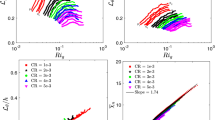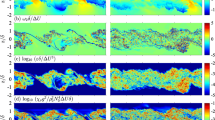Abstract
In this analysis the quantification of diapycnal diffusivity \(K_\rho\) in stratified flows such as those found in the ocean and atmosphere is explored. There are two simplifications that are routinely made when estimating mixing rates in stably stratified flows. First, a constant value is commonly assumed for the (irreversible) mixing coefficient \(\Gamma\). Second, dissipation rates of turbulent kinetic energy \(\epsilon\) are inferred using either the Thorpe (or Ellison) length scales or from microstructure measurements using the isotropy assumption. Data from three independent direct numerical simulations of homogeneous stratified turbulence are used as a testbed to highlight impacts of these assumptions on estimates of \(K_\rho\). A systematic analysis compares the inferred diffusivities to exact DNS diffusivities as a function of the turbulent Froude number \(Fr_t\). Use of a constant \(\Gamma\) results in an under-prediction of \(K_\rho\) by up to a factor of 5 for strongly stratified conditions (low \(Fr_t\)) and an over-prediction of \(K_\rho\) by up to two orders of magnitude in weakly stratified conditions (high \(Fr_t\)). The use of inferred dissipation rates \(\epsilon\) based on the assumption of isotropy results in an over-prediction of \(K_\rho\) by a factor of 2 for low \(Fr_t\) (which is within the instrumentation error) and converges on the exact \(K_\rho\) for \(Fr_t \ge 1\). However, the use of kinematic length scales, such as the Thorpe or Ellison scales, to infer \(\epsilon\) result in significant errors. The implications of these findings are applied in a simple demonstration to show how these tools can be used for improved estimates of mixing rates in stably stratified flows.





Similar content being viewed by others
References
Arthur RS, Venayagamoorthy SK, Koseff JR, et al (2017) How we compute N matters to estimates of mixing in stratified flows. J Fluid Mech 831(R2)
Bouffard D, Boegman L (2013) A diapycnal diffusivity model for stratified environmental flows. Dyn Atmos Oceans 61:14–34
Chalamalla VK, Sarkar S (2015) Mixing, dissipation rate, and their overturn-based estimates in a near-bottom turbulent flow driven by internal tides. J Phys Oceanogr 45(8):1969–1987
Danaila L, Voivenel L, Varea E (2017) Self-similarity criteria in anisotropic flows with viscosity stratification. Phys Fluids 29(2):020716
Dillon TM (1982) Vertical overturns: a comparison of Thorpe and Ozmidov length scales. J Geophys Res Oceans 87(C12):9601–9613
Ellison T (1957) Turbulent transport of heat and momentum from an infinite rough plane. J Fluid Mech 2(5):456–466
Fernando H (1991) Mixing efficiency in stratified shear flows. Annu Rev Fluid Mech 23:455–493
Garanaik A, Venayagamoorthy SK (2018) Assessment of small-scale anisotropy in stably stratified turbulent flows using direct numerical simulations. Phys Fluids 30(126):602
Garanaik A, Venayagamoorthy SK (2019) On the inference of the state of turbulence and mixing efficiency in stably stratified flows. J Fluid Mech 867:323–333
Gargett AE (1988) The scaling of turbulence in the presence of stable stratification. J Geophys Res Oceans 93(C5):5021–5036
Garrett C (2001) Stirring and mixing: What are the rate-controlling processes? Victoria University (British Columbia), Department of Physics and Astronomy, Technical report
Gregg MC, D’Asaro E, Riley JJ et al (2018) Mixing efficiency in the ocean. Ann Rev Mar Sci 10:443–473
Holford JM, Linden P (1999) Turbulent mixing in a stratified fluid. Dyn Atmos Oceans 30(2–4):173–198
Howland CJ, Taylor JR, Caulfield C (2020) Mixing in forced stratified turbulence and its dependence on large-scale forcing. J Fluid Mech 898
Hult E, Troy C, Koseff J (2011) The mixing efficiency of interfacial waves breaking at a ridge: 2. local mixing processes. J Geophys Res Oceans 116(C2)
Ijichi T, Hibiya T (2018) Observed variations in turbulent mixing efficiency in the deep ocean. J Phys Oceanogr 48(8):1815–1830
Itsweire E, Koseff J, Briggs D et al (1993) Turbulence in stratified shear flows: implications for interpreting shear-induced mixing in the ocean. J Phys Oceanogr 23(7):1508–1522
Ivey GN, Imberger J (1991) On the nature of turbulence in a stratified fluid. Part I: the energetics of mixing. J Phys Oceanogr 21(5):650–658
Jalali M, Sarkar S (2014) Turbulence and dissipation in a computational model of luzon strait. In: APS division of fluid dynamics meeting abstracts, pp E23–005
Jalali M, Sarkar S, Chalamalla VK (2016) Local turbulence and baroclinic energy balance in a Luzon strait model. Am Geophys Union 2016:PO34C-3072
Lewin S, Caulfield C (2021) The influence of far field stratification on shear-induced turbulent mixing. J Fluid Mech 928
Lindborg E, Brethouwer G (2008) Vertical dispersion by stratified turbulence. J Fluid Mech 614:303–314
Lozovatsky I, Fernando H (2013) Mixing efficiency in natural flows. Philos Trans Roy Soc A Math Phys Eng Sci 371(1982):20120213
Maffioli A, Davidson PA (2016) Dynamics of stratified turbulence decaying from a high buoyancy Reynolds number. J Fluid Mech 786:210–233
Maffioli A, Brethouwer G, Lindborg E (2016) Mixing efficiency in stratified turbulence. J Fluid Mech 794:R3
Mashayek A, Caulfield C, Peltier W (2013) Time-dependent, non-monotonic mixing in stratified turbulent shear flows: implications for oceanographic estimates of buoyancy flux. J Fluid Mech 736:570–593
Mashayek A, Salehipour H, Bouffard D et al (2017) Efficiency of turbulent mixing in the abyssal ocean circulation. Geophys Res Lett 44(12):6296–6306
Mashayek A, Caulfield C, Alford M (2021) Goldilocks mixing in oceanic shear-induced turbulent overturns. J Fluid Mech 928
Mater BD, Venayagamoorthy SK (2014) The quest for an unambiguous parameterization of mixing efficiency in stably stratified geophysical flows. Geophys Res Lett 41(13):4646–4653
Mater BD, Schaad SM, Venayagamoorthy SK (2013) Relevance of the thorpe length scale in stably stratified turbulence. Phys Fluids 25(7):076604
Monismith SG, Koseff JR, White BL (2018) Mixing efficiency in the presence of stratification: When is it constant? Geophys Res Lett 45(11):5627–5634
Mukherjee P, Balasubramanian S (2021) Diapycnal mixing efficiency in lock-exchange gravity currents. Phys Rev Fluids 6(1):013801
Munk W, Wunsch C (1998) Abyssal recipes II: energetics of tidal and wind mixing. Deep Sea Res Part I 45(12):1977–2010
Osborn TR (1980) Estimates of the local rate of vertical diffusion from dissipation measurements. J Phys Oceanogr 10(1):83–89
Osborn TR, Lueck RG (1985) Turbulence measurements with a submarine. J Phys Oceanogr 15(11):1502–1520
Ozmidov RV (1965) On the turbulent exchange in a stably stratified ocean. izv. acad. sci. ussr. Atmos Ocean Phys 1:861–871
Peltier WR, Caulfield CP (2003) Mixing efficiency in stratified shear flows. Annu Rev Fluid Mech 35:135–167
Salehipour H, Peltier WR (2015) Diapycnal diffusivity, turbulent Prandtl number and mixing efficiency in Boussinesq stratified turbulence. J Fluid Mech 775:464–500
Shih LH, Koseff JR, Ferziger JH et al (2000) Scaling and parameterization of stratified homogeneous turbulent shear flow. J Fluid Mech 412:1–20
Shih LH, Koseff JR, Ivey GN et al (2005) Parameterization of turbulent fluxes and scales using homogeneous sheared stably stratified turbulence simulations. J Fluid Mech 525:193–214
Smyth WD, Moum JN (2000) Anisotropy of turbulence in stably stratified mixing layers. Phys Fluids 12(6):1343–1362
Thorpe SA (1977) Turbulence and mixing in a Scottish loch. Philos Trans Roy Soc Lond Ser A Math Phys Sci 286(1334):125–181
Thorpe SA (2005) The turbulent ocean. Cambridge University Press, Cambridge
Venayagamoorthy SK, Koseff JR (2016) On the flux Richardson number in stably stratified turbulence. J Fluid Mech 798
Venayagamoorthy SK, Stretch DD (2010) On the turbulent Prandtl number in homogeneous stably stratified turbulence. J Fluid Mech 644:359–369
Wesson J, Gregg M (1994) Mixing at Camarinal sill in the strait of Gibraltar. J Geophys Res Oceans 99(C5):9847–9878
Winters KB, Lombard PN, Riley JJ et al (1995) Available potential energy and mixing in density-stratified fluids. J Fluid Mech 289:115–128
Acknowledgements
The authors would like to thank and acknowledge Dr. Andrea Maffioli and Dr. Lucinda Shih for providing their DNS data. SKV and MRK gratefully acknowledge funding from the Office of Naval Research (N00014- 18-1-2773 and N00014-22-1-2043) and the National Science Foundation under Grant No. OCE-2149047.
Author information
Authors and Affiliations
Contributions
Both authors have contributed equally to this work.
Corresponding author
Ethics declarations
Conflict of interest
The authors have no conflicts to disclose.
Additional information
Publisher's Note
Springer Nature remains neutral with regard to jurisdictional claims in published maps and institutional affiliations.
Rights and permissions
Springer Nature or its licensor (e.g. a society or other partner) holds exclusive rights to this article under a publishing agreement with the author(s) or other rightsholder(s); author self-archiving of the accepted manuscript version of this article is solely governed by the terms of such publishing agreement and applicable law.
About this article
Cite this article
Klema, M.R., Venayagamoorthy, S.K. Mixing rates in stably stratified flows with respect to the turbulent froude number and turbulent scales. Environ Fluid Mech 23, 1037–1049 (2023). https://doi.org/10.1007/s10652-023-09925-1
Received:
Accepted:
Published:
Issue Date:
DOI: https://doi.org/10.1007/s10652-023-09925-1




